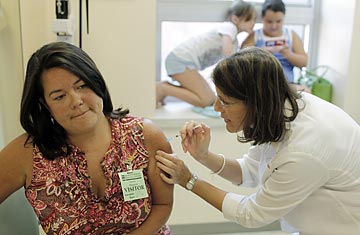
Julie Halvorsen, left, receives the second dose of the trial swine flu vaccine from nurse Kim Rincavage at the University of Maryland Medical Center in Baltimore
Small businesses already hit hard by the recession may soon undergo another pummeling, this time by the 2009 H1N1 virus, the frightening new subtype of a strain that's been around for decades.
"Right now the bulk of smaller businesses haven't prepared," says Howard A. Mavity, a labor lawyer who heads up the workplace safety and catastrophe management practice group at Fisher & Phillips, in Atlanta.
Overall, however, interest in how best to address a viral onslaught is intense, says Mavity, noting that inquiries from businesses of all sizes about his firm's free webinars on workplace-related H1N1 topics have increased "tenfold" since the summer.
Why then have so few small to midsize companies executed a blueprint for action?
The overall excuse that Mavity hears from companies that have yet to draft their emergency plans tends to be lack of time. But other issues have added to the turmoil.
Many small businesses have cut back their staff to the minimum, so they are without the extra workers needed to plan for contingencies.
But small businesses are also more vulnerable than large companies precisely because they work with a light staff — lose two workers to the flu and a shop's workforce can be cut in half for a week or more. And, says Mavity, even if a company had the foresight to buy insurance in the event that a catastrophe disrupted the business, policies are often so narrowly construed that they probably would not offer protection against a flu pandemic.
Then there's the fear of H1N1 mutation into a more lethal virus. "The 2009 H1N1 virus has not changed or evolved, and the vaccine for it is the best match with any flu strain we've had for decades," says Joe Quimby, a spokesman for the Centers for Disease Control and Prevention. "But we can't speculate about what could happen in the months to come."
While a potential H1N1 pandemic may be complex to consider, workplace plans to address it can be quite simple. Mavity characterizes these as little more than well-thought-out checklists, generally drafted by department heads, which detail who does what to keep the business running. He advises companies to name two coordinators of the emergency plan itself "in case one gets felled by the virus," and to cross-train contingency people. Prioritizing is essential. If your company's lifeblood depends on, say, IT, says Mavity, make sure you allocate enough resources to it, like adding a second Web master to your roster.
An epidemic might also fuel a rash of telecommuting requests from employees who do not normally do it. However, says Mavity, increased telecommuting greatly increases a company's electronic security risks, especially with flu-ridden children exposed to trade secrets and highly confidential information.
At the other end of the spectrum are businesses that have planned for the flu but don't necessarily know how far they can go legally. "The question I'm hearing a lot is, Can employers send workers home involuntarily?" says Daniel P. O'Meara, a labor lawyer at Montgomery, McCracken, in Berwyn, Pa. The Occupational Safety and Health Act contains a general duties clause that specifies that employers must keep a safe workplace, which can be used to justify sending a sick employee home, he says. In this sluggish economy, however, resistance is to be expected.
"Some employers are worried that people will come to work sick because of fear of being laid off," says O'Meara. He suggests that owners assuage those concerns by adapting flexible policies, such as letting staffers who have used up all their paid days off borrow from next year's allotment, telecommute or make up the lost time in other ways. The important thing, he says, is to follow government guidelines, send your employee home, and worry later how and if to pay them.
Small businesses and organizations with general emergency plans already in place are one step ahead of the game. "Adding an H1N1 component to our overall plan increased employee awareness of the issue," says Pat Meller, CFO of the nonprofit Philadelphia Foundation. She plans to use the organization's intranet to link to local websites that provide information about vaccination and other preventive measures. One challenge, she says, is getting her mostly 20- and 30-something workforce to take the potential epidemic seriously. "Young people tend to think it won't happen to them, so we're giving everyone a kit that includes hand sanitizer and tissues — something tangible to remind them of the issue."
